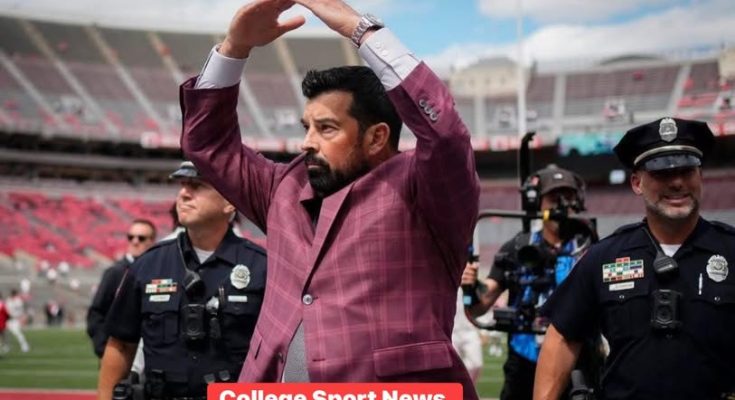Ryan Day has built a reputation as one of the most aggressive recruiters in college football, and his willingness to go head-to-head with powerhouse programs from the SEC has only solidified Ohio State’s national brand. Recruiting is no longer a regional battle; it’s a national arms race where coaches have to travel into enemy territory, challenge the strongest schools in the country, and convince elite prospects that Columbus is a better home for them than the likes of Athens, Tuscaloosa, Baton Rouge, or Gainesville. What makes this particular situation so fascinating is that Day isn’t just pursuing another high-profile name, he’s doing it deep in SEC country, right in the backyard of programs that don’t often lose local five-star athletes to northern schools. When an SEC program sees an Ohio State coach step into their region and start building relationships, it feels like someone trespassing in a guarded space, and that tension makes these recruiting battles some of the most entertaining storylines in college football.
Ohio State under Ryan Day has become a factory for developing NFL talent, particularly on offense. Quarterbacks like Justin Fields, C.J. Stroud, and now potentially Air Noland and Julian Sayin are the kinds of names that stand out to skill players looking for development. Wide receivers see the lineage from Michael Thomas to Garrett Wilson to Chris Olave to Marvin Harrison Jr., and they realize Columbus has become “WRU.” Defensive stars have also flourished, with Chase Young and the Bosa brothers setting the standard for linemen. That track record resonates with prospects, and it allows Day to confidently step into any recruiting region knowing he has proof of results. Still, SEC programs pride themselves on recruiting dominance, and a five-star prospect from the South often feels like their birthright. If Day is able to walk away with a commitment from such a player, it not only changes Ohio State’s roster but also delivers a psychological blow to SEC rivals.
The SEC has long marketed itself as the premier destination for players seeking NFL preparation. The conference’s dominance in the College Football Playoff, its record for producing draft picks, and the fervor of its fan bases make it hard to argue against its influence. Coaches like Nick Saban, Kirby Smart, and Brian Kelly have built entire recruiting strategies around locking down their states and surrounding regions. The idea is simple: keep five-star talent close to home and make it very difficult for out-of-region programs to make inroads. That’s why this pursuit by Day is particularly bold. He is saying, essentially, that Ohio State will not be boxed into Big Ten borders. He is putting himself in direct competition with the very machine that has produced countless national titles, Heisman winners, and NFL stars. And make no mistake, this is not the first time Ohio State has waged this type of battle.
The Buckeyes have historically pulled elite talent from the South. Think back to Jeff Okudah from Texas, Baron Browning also from Texas, or more recently Jeremiah Smith out of Florida, the top wide receiver in his class. Those commitments sent shockwaves through recruiting circles because they showed that Ohio State could break through SEC walls. What Ryan Day is attempting to do now is carry that tradition forward, showing that the Buckeyes are not afraid of taking on the most powerful schools in the most talent-rich regions of the country. For fans, the drama lies not only in whether the commitment will happen but also in watching the subtle back-and-forth moves that play out in the process. One week, insiders might say the SEC program feels confident. The next week, whispers come out that Ohio State has surged ahead. Recruiting battles have become a sport within the sport, and this one is a perfect example of that theater.
From the player’s perspective, choosing Ohio State over a local SEC giant can be both appealing and challenging. On one hand, Ohio State offers a chance to be part of a national brand with consistent playoff appearances and an unmatched history of sending talent to the NFL. On the other hand, there is often significant pressure to stay local. Family members, community leaders, and friends might lean toward the SEC option, especially if that school is just a couple of hours away and has its own legacy of success. That tug-of-war adds an emotional layer to the decision. Ryan Day’s job, along with his staff, is to present a vision so compelling that it outweighs the comfort of staying close to home. They must convince the player and his family that Columbus will provide the best development, the best exposure, and the clearest path to success.
One thing Ohio State does better than almost anyone is use its national platform to market players. When you’re playing on FOX Big Noon Kickoff nearly every week, competing in primetime games, and contending for Big Ten and national titles, your highlights are going to be seen by everyone. NFL scouts pay attention. Media outlets constantly feature Ohio State stars. For a five-star prospect considering his legacy, that visibility matters. Ryan Day understands this, and he leverages it in recruiting conversations. The message is simple: “Come to Ohio State, and the whole country will know your name. Stay at home, and you may share the spotlight.” That kind of pitch can be persuasive, especially for elite players with professional aspirations.
Still, it would be naïve to think that SEC programs will roll over and let Day waltz into their territory unopposed. These schools will bring out every weapon in their arsenal to keep a five-star talent home. That includes showing off their facilities, flaunting NIL opportunities, and pointing to the number of first-round picks they’ve produced. The SEC can counter Ohio State’s “national exposure” argument with its own evidence: look at the NFL Draft boards loaded with SEC alumni year after year. They can remind prospects of the comfort of staying close to home, playing in front of family, and competing in what many argue is the most challenging conference in football. This is why recruiting wars like this feel like heavyweight fights. Each side has legitimate advantages, and the outcome often depends on relationships and trust built over months of conversations.
For Ryan Day, winning this battle would send a statement that resonates far beyond the single commitment. It would reinforce Ohio State’s ability to recruit anywhere, further solidify the Buckeyes as a national recruiting power, and potentially open the door for more future recruits from SEC territory to consider leaving the region. It also serves notice to the SEC programs themselves: Ohio State is not afraid to challenge their dominance in their own backyard. For SEC coaches, losing a five-star to Ohio State is more than just losing one player—it’s a breach in the wall they’ve spent years fortifying. That kind of loss can be used against them in future recruiting pitches, and it can embolden other northern programs to try their luck in the South as well.
Fans of college football know that recruiting shapes the future of the sport as much as Saturday results do. A single five-star commitment can shift the balance of power, determine playoff paths, and even influence coaching careers. When Ryan Day plants a flag in SEC territory, fans from all sides take notice. Ohio State supporters see it as evidence of their program’s reach and competitiveness. SEC fans view it as a challenge to their pride and dominance. Neutral fans enjoy the spectacle of watching two recruiting giants trade blows. It’s drama, politics, and strategy all wrapped into one.
As this recruiting battle unfolds, it’s worth asking: what does it say about the current landscape of college football? It shows us that no program, no matter how strong locally, can afford to take recruiting for granted. The transfer portal, NIL opportunities, and the national reach of television have blurred regional lines. A kid from Georgia or Alabama can easily imagine himself thriving in Ohio, Michigan, or even Oregon. Similarly, northern schools no longer feel confined to their own regions. Ryan Day’s pursuit of a five-star player in SEC country embodies this shift perfectly. It is college football’s new reality, one where tradition still matters but boldness and creativity matter even more.
Ultimately, whether or not Ohio State lands this particular prospect, the pursuit itself is important. It sends a message about Day’s confidence, ambition, and willingness to compete with the very best. For Ohio State fans, it’s another reason to believe their program won’t just keep up with the SEC—they’ll continue to challenge it head-on. For SEC fans, it’s a reminder that the competition is never resting, and even their strongest pipelines can be contested. And for the player at the center of it all, it’s a life-altering decision that will shape his career, his development, and his legacy.
Now, this is where I’d love to hear from you. Do you think Ryan Day can realistically win this type of battle consistently, or do you believe the SEC will always hold the upper hand when it comes to keeping their best players at home? Is Ohio State’s national reach strong enough to break through the regional loyalties that so often define recruiting decisions? And most importantly, what do you think it would mean for the balance of college football if programs like Ohio State start consistently pulling five-stars straight out of SEC territory? Your thoughts, your perspectives, and your takes on this situation can add so much to the conversation, so don’t be shy—drop a comment and join in. After all, recruiting isn’t just about coaches and players, it’s also about fans like you who keep the debate alive and the passion burning.



